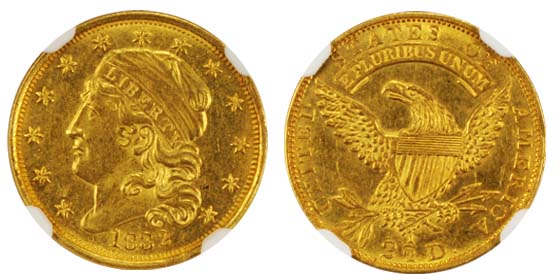Capped Bust Quarter Eagle Values
How Much Capped Bust Quarter Eagles are Worth: Capped Bust Quarter Eagle Values & Coin Price Chart

Year | Mint | Variety | Designation | VG-8 | F-12 | VF-20 | EF-40 | AU-50 | U-60 | MS-63 | MS-64 | MS-65 | MS-66 | MS-67 |
|---|---|---|---|---|---|---|---|---|---|---|---|---|---|---|
1800 | P | Plain 4- Stemless Wreath | Red-brown | 200 | 300 | 400 | 500 | 600 | 700 | 800 | 900 | 1000 | 1200 | 1100 |
| Year | Mint | Variety | Designation | VG-8 | F-12 | VF-20 | EF-40 | AU-50 | MS-60 | MS-63 | MS-64 | MS-65 | MS-66 |
|---|---|---|---|---|---|---|---|---|---|---|---|---|---|
| 1808 | (None) Phil | 125-150 Known SRS: R4 | -- | -- | $48,400 | $59,400 | $133,000 | $161,750 | $300,000 | $625,000 | $917,500 | $2,832,500 | -- |
| 1821 | (None) Phil | 40-60 Known SRS: R5 | -- | -- | $6,820 | $8,250 | $13,275 | $16,710 | $36,525 | $130,000 | $221,250 | $354,000 | $680,000 |
| 1824/1 | (None) Phil | 46-60 Known SRS: R5 | -- | -- | $6,820 | $8,250 | $13,275 | $16,710 | $38,175 | $91,300 | $139,750 | -- | -- |
| 1825 | (None) Phil | 100-150 Known SRS: R4 | -- | -- | $8,270 | $9,900 | $13,825 | $17,975 | $40,100 | $83,000 | $127,250 | $200,500 | $382,000 |
| 1826/6 | (None) Phil | 30-35 Known SRS: R5+ | -- | -- | $13,750 | $20,875 | $30,000 | $41,750 | $109,250 | $282,000 | -- | -- | -- |
| 1827 | (None) Phil | 46-60 Known | -- | -- | $8,160 | $9,625 | $13,853 | $17,425 | $36,800 | $82,175 | $127,250 | $200,500 | $264,000 |
| 1829 | (None) Phil | 75-125 Known SRS: R4+ | -- | -- | $5,720 | $6,820 | $12,450 | $15,600 | $26,000 | $42,300 | $72,750 | $146,500 | $211,500 |
| 1830 | (None) Phil | 80-120 Known SRS: R4 | -- | -- | $7,110 | $8,410 | $12,450 | $15,875 | $26,275 | $40,650 | $67,250 | $126,700 | $200,500 |
| 1831 | (None) Phil | 110-140 Known SRS: R4 | -- | -- | $5,720 | $6,820 | $12,450 | $15,600 | $26,000 | $44,500 | $67,250 | $135,500 | $211,500 |
| 1832 | (None) Phil | 80-120 Known | -- | -- | $5,720 | $6,820 | $12,450 | $15,600 | $27,100 | $44,500 | $71,100 | $140,500 | -- |
| 1833 | (None) Phil | 60-90 Known SRS: R4+ | -- | -- | $5,720 | $6,820 | $12,450 | $15,600 | $26,000 | $40,650 | $67,250 | $126,700 | $200,500 |
| 1834 | (None) Phil | 18-24 Known SRS: R6 | -- | -- | $28,600 | $38,500 | $81,900 | $143,250 | $235,000 | $326,250 | -- | -- | -- |
Coin Description and History
The Capped Bust Quarter Eagle holds a special place in the hearts of investors and coin collectors. Struck by the United States Mint between 1796 and 1834, this coin encapsulates the young American nation’s rich history and evolving artistry.
History of the Capped Bust Quarter Eagle
The Capped Bust Quarter Eagle emerged in a significant growth and change era for the United States Mint. With a face value of $2.50, it was part of the early gold coinage crucial to commerce and trade in the burgeoning nation. The series is generally divided into two main types: the “Capped Bust to Right, No Stars” (1796 only) and the “Capped Bust to Right, Stars on Obverse” (1808-1834). Its production spanned a period that saw the United States evolve politically and economically.
Designer’s History
The Capped Bust Quarter Eagle was the creation of two notable figures in the Mint’s history: Robert Scot and John Reich. Robert Scot, the first Chief Engraver of the United States Mint, designed the initial 1796 version. Known for his contributions to early U.S. coinage, Scot’s designs reflect the neoclassical style popular at the time. In 1808, John Reich, hired by the Mint for his remarkable talents, refined Scot’s design, adding stars to the obverse and making other adjustments that enhanced the coin’s aesthetic appeal.
Mintage Information
The mintage of the Capped Bust Quarter Eagle was sporadic and limited, reflecting the Mint’s operational challenges and the gold supply. The total production was modest, particularly for the 1796 “No Stars” and the 1808 issues, making these coins exceedingly rare and highly sought after by collectors.
- 1796 “No Stars”: Characterized by the absence of stars on the obverse, it is one of the most coveted coins, with a minimal mintage.
- 1796-1807 “Stars on Obverse”: No coins were minted between 1797 and 1807, making the 1796 with stars and later issues particularly rare.
- 1808-1834 “Stars on Obverse”: Mintage numbers were slightly higher but still limited, with several years not seeing any production.
